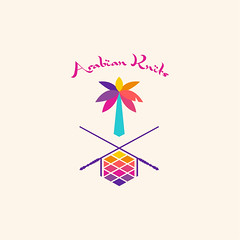Tuesday, February 24, 2015
Yarn Along: Slowing Down

Does that shawl look the same size as it was when I showed you last week? You know how I mentioned that I had to redo portions frequently? I'm only one repeat ahead of where I was last week. That is a bit troubling to me, as I have to have it finished by either the 8th or 10th of March. Amira's birthday party is either going to be the Sunday before her birthday so I will need it to give her during the party, or I will need it to give her for a ballet performance we will be attending with a few of her friends.

A few people asked for the photo of Saint Helena before they decided to commit. So, here it is. I don't have a picture of it finished, as this was my prototype, and I've reworked the pattern a bit. It is knit in the round, using aran weight yarn, simple color changes such as striping and some minimal stranding, and can use bits and bobs left over from other projects quite easily. Please e-mail me or leave a comment with contact information if you are interested in testing the pattern. I have a facebook group to add you to if you are able to help me this way, and you can talk to other people working on it as well as me. (And I promise you will get something nice - besides the pair of mitts you make - if you finish them, something even more if you let me use your photo!)
I started and finished Eleanor & Park
Likewise, I started The Lost Art of Dress: The Women Who Once Made America Stylish
The cultural rebellion of the 1960s undermined the Dress Doctors from all sides. The home economists among them had claimed a place at the vanguard of professional women in the 1920s, but now they seemed hopelessly old-fashioned as women demanded the right to work in all fields. When radical feminist Robin Morgan spoke at the annual meeting of the American Home Economics Association in 1972, she told the women in her audience, many of them teachers, that the best thing they could do for young women was quit their jobs. By the mid-1970s, funding for home economics programs in public schools was being slashed on the grounds that their classes encouraged sexual stereotypes. Ambitious young women turned to other professions.
The art principles also came under attack during the "Youthquake" movement of the 1960s. The Baby Boomers opted for shocking color schemes that created anything but the artistic repose espoused by the Dress Doctors. The sophisticated fashion models of the 1950s sometimes worked into their forties, but now the fashion world celebrated youth and youth alone.
I found it interesting that home economics was gutted the way teaching was gutted and nursing was gutted by denigration from other women who, rather than trying to expand the options available to women by inspiring them to achieve in other fields as well, had to demean and belittle the areas and fields that were traditionally feminine. Whereas once these careers were seen as highly desirable and something of a bit of status for a working woman, her work was seen as evidence of her intelligence and skill, now they were considered the lowly options that the unambitious sought. None of them has been bettered by this attitude. Likewise, I found it interesting that the people who now bemoan the lack of options and regard for mature, older women, were part of the movement that shoved off their older sisters and have created a, seemingly, permanent temple to youth in our culture.
This week, I even had a chance to read more in Christ in His Saints

Also posting to Keep Calm and Craft On
Labels: Books, Crochet, Design, Homemaking, Knitting, Reviews, Yarn Along
Comments:
<< Home
I enjoyed your commentary on "The Lost Art of Dress" -- the culture has changed to be sure, and that it has been purposefully done, saddens me. Thankfully, we are free to occupy our time and to dress ourselves in accordance with our consciences! Best wishes on finishing your shawl! :)
Thank you for your comment!
I agree with you and am also glad that we can choose to dress according to our consciences and taste. It is interesting to be reading some of the art principles, though, and I'm finding that to be helpful to me.
Some of the commonly mocked (now) advice from the 50s, for instance, of a woman changing her clothes and freshening her hair and makeup before her husband came home actually was coupled with the advice that it was better to neglect the housework to do this, since it would allow her to be and feel more relaxed and lift her spirits to express her personality in her dress, as her daytime clothes were essentially work clothes. I had never read that part before, and it makes the rest of it not sexist, but liberating. Women were essentially told that the dirt would always be there, but the home was not made a home by being immaculate, but rather by the happy, comfortable people in it. And what woman now doesn't feel her attitude lift when she puts on something she likes or fixes her hair as she finds attractive or swipes some lipstick on? Most women I know feel better when they look better (to themselves) and that was what the advice was based in. Yes, it was to please the husband, too, but it was primarily about making the shift between work and leisure that he automatically made by leaving his place of work and coming home, but which was more difficult for her to delineate, as her workplace was her home. I think as a homeschool mom who does so much at home, I will be applying this, not to be some patronized little wifey, but to make that switch from workday to rest.
Post a Comment
I agree with you and am also glad that we can choose to dress according to our consciences and taste. It is interesting to be reading some of the art principles, though, and I'm finding that to be helpful to me.
Some of the commonly mocked (now) advice from the 50s, for instance, of a woman changing her clothes and freshening her hair and makeup before her husband came home actually was coupled with the advice that it was better to neglect the housework to do this, since it would allow her to be and feel more relaxed and lift her spirits to express her personality in her dress, as her daytime clothes were essentially work clothes. I had never read that part before, and it makes the rest of it not sexist, but liberating. Women were essentially told that the dirt would always be there, but the home was not made a home by being immaculate, but rather by the happy, comfortable people in it. And what woman now doesn't feel her attitude lift when she puts on something she likes or fixes her hair as she finds attractive or swipes some lipstick on? Most women I know feel better when they look better (to themselves) and that was what the advice was based in. Yes, it was to please the husband, too, but it was primarily about making the shift between work and leisure that he automatically made by leaving his place of work and coming home, but which was more difficult for her to delineate, as her workplace was her home. I think as a homeschool mom who does so much at home, I will be applying this, not to be some patronized little wifey, but to make that switch from workday to rest.
<< Home



